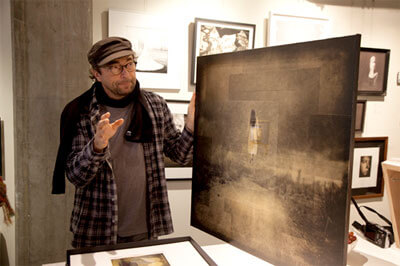
Kamil Vojnar was born in the former Czechoslovakia in 1962. He studied at the School of Graphic Arts in Prague and began his career as a Graphic Designer. He left the country illegally (still Communist at the time) and moved to Vienna, and then eventually became a US citizen and finished his studies at the Art Institute of Philadelphia. He continued his career in Graphic Design which later led to illustration and imagery based on photography, working mostly for book and music publishing houses in New York City. At the same time, he continued to make his own imagery. After meeting his partner and having children, going back and forth between France and New York, they finally settled in St. Remy de Provence in South France where Vojnar has concentrated on his own work since 2005. He opened up an Atelier in St. Remy and then one in Paris in 2009, both of which carry his own work.
His work consists of images digitally layered from many different photographs and textures. They are mixed-media archival prints on fine art paper or mounted on canvas. Some of his images are layered pictures printed on semitransparent Thai paper. These unique photomontages are then varnished with oil and wax, and on occasion painted with oil paints. Kamil, as a painter, points out, “In a painting, you can paint anything you want. In the photographic [medium], it must, on some level, exist first. That tension between what exists and what is made up is what interests me.” Thus, his images are often subject to very different interpretations
(Source: Verve Gallery)
About Elsewhere
Well, … why … why "e l s e w h e r e"…?
Because, … not really here, because not there or … over there, because … somewhere else, … "e l s e w h e r e"!!!
In thousand years old small town in south France, I have little studio, tiny Gallery, up on the main street.
People from all around the world come to this town. They walk it's ancient streets. Some see my place, some walk in and look around.
And they ask … why, … the sky outside is blue, … the buildings ochre yellow, the olive trees pale green, … why are those pictures musty, sepia, dark. Why is their soul heavy? What happened? What has happened to me!
And I say … I don't know, … they come to me that way. They are not really from here, they are not so much from there. They arrive from ..."elsewhere". I am just a pair of hands making them happen.
I didn't look for them, I didn't choose them. They came to me, … they choose me!
Artist? No. … Common' I am no Artist! I just make those little pictures. Just because they happen to me.
And because … I cannot do anything else. I cannot do anything else, at least, until every last of them is out, … done.
Just a pair of hands I am. Always struggling to let the image out. Always behind in my ability to execute on the paper what pours from ..."elsewhere", via my mind, my heart.
It feels like, … really I have no personal connection to those pictures. I am not guilty.
Don't ask me what they are, … what they mean. I don't know.
Like orphaned kids, I collect them, feed them to grow.
They have to be done. They have to get out there.
If not me, … then who?
Some are easy. Impatiently they bursting out into the open
Others play hide and seek. They leave a hint, they take me all over wrong paths, all around. They let me sweat, they let me freeze. They drag me through dry, dusty deserts, soak me in deepest seas. My shirt is bloody. My face is wet. Sometimes … sometimes I cry. Pure impossibility overwhelms me. Impossibility to make them happen as they appear to me. In their translucent light, through the tears, I see them, … I almost see them.
No, I am no Artist. I just … I am just trying to do, … what I … almost … see.
Yes, it's true! … I am making one picture over and over again.
The same sofa, the same dress, the same image of Jesus on the wall in the background, as I have had throughout my childhood.
Wings? … Yes, sometimes, there are wings. But those who carry them, they are no angels.
They just want to be free. Pair of wings is like a passport to get away. To get to … elsewhere.
E l s e w h e r e, … they say, it's not the destination, it's the journey, that counts.
Therefore my little pictures are the humble documentation of that journey.
They are the journey!
Journey to … e l s e w h e r e!